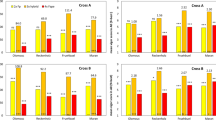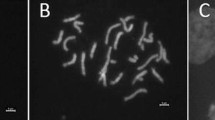Abstract
The Continental morphotype of tall fescue is one of the main forage and turf grass species. However, it suffers from summer drought, especially in dry and hot climates. On the other hand, the Mediterranean morphotype of tall fescue display summer dormancy. Hybridization of the two morphotypes seems to be an efficient way to introgress summer dormancy from Mediterranean morphotypes into elite cultivars of the Continental morphotype. In this study, we performed a series of reciprocal crosses producing F1 hybrids. Phenotyping revealed heterosis for plant height, fresh weight and dry matter yield, with hybrids generally outscoring parental genotypes. On the other hand, F1 hybrids had reduced fertility and lower seed set. This was a consequence of meiotic irregularities. Both parental morphotypes carry chromosome pairing regulators responsible for diploid-like behavior in meiosis. However, it is clear from this study that the regulators from the two morphotypes are not compatible. We observed high frequency of multivalent formation and homoeologous chromosome pairing in F1 hybrids. Molecular and cytogenetic analyses indicate high level of genome differentiation between both morphotypes. This might be caused either by massive genome reshuffling during the evolution or, most likely, by origination of the two morphotypes from different parental species. As such, introgression-form of breeding involving several rounds of backcrosses resulting in the restoration of chromosome pairing regulator (at least in some plants) appears to be the only way to achieve stability of the hybrid genomes and thus, wider utilization of genetically stable and fertile hybrid tall fescue for forage and turf.






Similar content being viewed by others
References
Barcaccia G, Meneghetti S, Albertini E, Triest L, Lucchin M (2003) Linkage mapping in tetraploid willows: segregation of molecular markers and estimation of linkage phases support an allotetraploid structure for Salix alba × Salix fragilis interspecific hybrids. Heredity 90:169–180
Crow JF (1998) 90 Years ago: the beginning of hybrid maize. Genetics 148:923–928
Dierking R, Azhaguvel P, Kallenbach R, Saha M, Bouton J, Chekhovskiy K, Kopecký D, Hopkins A (2015) Linkage maps of a Mediterranean × Continental tall fescue population and their comparative analysis with other Poaceae species. Plant Genome. https://doi.org/10.3835/plantgenome2014.07.0032
Eizenga GC (1989) Meiotic analyses of tall fescue somaclones. Genome 32:373–379
Gauder M, Graeff-Hönninger S, Lewandowski I, Claupein W (2012) Long-term yield and performance of 15 different Miscanthus genotypes in southwest Germany. Ann Appl Biol 160:126–136
Ghesquiere M, Humphreys MW, Zwierzykowski Z (2010) Festulolium. Fodd Crops Amenity Grasses 5:293–316
Grivet L, Dhont A, Roques D, Feldmann P, Lanaud C, Glaszmann JC (1996) RFLP mapping in cultivated sugarcane (Saccharum spp): genome organization in a highly polyploid and aneuploid interspecific hybrid. Genetics 142:987–1000
Hand ML, Cogan NO, Stewart AV, Forster JW (2010) Evolutionary history of tall fescue morphotypes inferred from molecular phylogenetics of the Lolium-Festuca species complex. BMC Evol Biol 10:303
Humphreys MW, Thomas HM, Morgan WG, Meredith MR, Harper JA, Thomas H, Zwierzykowski Z, Ghesquiere M (1995) Discriminating the ancestral progenitors of hexaploid Festuca-Arundinacea using genomic in-situ hybridization. Heredity 75:171–174
Humphreys M, Feuerstein U, Vandewalle M, Baert J (2010) Ryegrasses. Fodd Crops Amenity Grasses 5:211–260
Hunt KL, Sleper DA (1981) Fertility of hybrids between 2 geographic races of tall fescue. Crop Sci 21:400–404
Jauhar PP (1975) Genetic-control of diploid-like meiosis in hexaploid tall fescue. Nature 254:595–597
Jauhar PP (1993) Cytogenetics of the Festuca-Lolium complex. Relevance to breeding, vol 18. Monographs on theoretical and applied genetics. Springer, Berlin, p 255
Jenczewski E, Alix K (2004) From diploids to allopolyploids: the emergence of efficient pairing control genes in plants. Crit Rev Plant Sci 23:21–45
Klie M, Schie S, Linde M, Debener T (2014) The type of ploidy of chrysanthemum is not black or white: a comparison of a molecular approach to published cytological methods. Front Plant Sci 5:479
Kopecký D, Loureiro J, Zwierzykowski Z, Ghesquiere M, Dolezel J (2006) Genome constitution and evolution in Lolium × Festuca hybrid cultivars (Festulolium). Theor Appl Genet 113:731–742
Kopecký D, Bartos J, Zwierzykowski Z, Dolezel J (2009) Chromosome pairing of individual genomes in tall fescue (Festuca arundinacea Schreb.), its progenitors, and hybrids with Italian ryegrass (Lolium multiflorum Lam.). Cytogenet Genome Res 124:170–178
Kopecký D, Havrankova M, Loureiro J, Castro S, Lukaszewski AJ, Bartos J, Kopecka J, Dolezel J (2010) Physical distribution of homoeologous recombination in individual chromosomes of Festuca pratensis in Lolium multiflorum. Cytogenet Genome Res 129:162–172
Kopecký D, Martis M, Cihalikova J, Hribova E, Vrana J, Bartos J, Kopecka J, Cattonaro F, Stoces S, Novak P, Neumann P, Macas J, Simkova H, Studer B, Asp T, Baird JH, Navratil P, Karafiatova M, Kubalakova M, Safar J, Mayer K, Dolezel J (2013) Flow sorting and sequencing meadow fescue chromosome 4F. Plant Physiol 163:1323–1337
Malik CP, Thomas PT (1966) Chromosomal polymorphism in Festuca arundinacea. Chromosoma 18:1–18
Malik CP, Thomas PT (1967) Cytological relationships and genome structure of some Festuca species. Caryologia 20:1–39
Mather K (1957) The measurement of linkage in heredity, 2nd edn. Methuen and Co, London
Rognli OA, Saha MC, Bhamidimarri S, van der Heijden S (2010) Fescues. Fodd Crops Amenity Grasses 5:261–292
Saha MC, Mian R, Zwonitzer JC, Chekhovskiy K, Hopkins AA (2005) An SSR- and AFLP-based genetic linkage map of tall fescue (Festuca arundinacea Schreb.). Theor Appl Genet 110:323–336
Sears ER, Okamoto M (1958) Intergenomic relationships in hexaploid wheat. In: Proceedings of Xth international congress of genetics, vol 2, pp 258–259
Shull GH (1908) The composition of a field of maize. Am Breed Assoc Rep 4:296–301
Solati Z, Manevski K, Jorgensen U, Labouriau R, Shahbazi S, Laerke PE (2018) Crude protein yield and theoretical extractable true protein of potential biorefinery feedstocks. Ind Crops Prod 115:214–226
Talukder SK, Azhaguvel P, Chekhovskiy K, Saha MC (2018) Molecular discrimination of tall fescue morphotypes in association with Festuca relatives. PLoS ONE 13:e0191343
Wendel JF (2000) Genome evolution in polyploids. Plant Mol Biol 42:225–249
Wendel JF, Jackson SA, Meyers BC, Wing RA (2016) Evolution of plant genome architecture. Genome Biol 17:37
Wu KK, Burnquist W, Sorrells ME, Tew TL, Moore PH, Tanksley SD (1992) The detection and estimation of linkage in polyploids using single-dose restriction fragments. Theor Appl Genet 83:294–300
Zwierzykowski Z, Joks W, Naganowska B (1993) Amphitetraploid hybrids Festuca pratensis Huds. × Lolium multiflorum Lam. [= Festulolium braunii (K. Richter) A. Camus]. Biul. IHAR 188:61–69 (in Polish with English summary)
Acknowledgements
We express our thank you to Prof. Adam J. Lukaszewski (University of California, Riverside) for his critical reading and valuable comments.
Funding
Funding was provided by National program of sustainability I (Grant No. LO1204) and European Regional Development Fund (Grant No. CZ.02.1.01/0.0/16_019/0000827).
Author information
Authors and Affiliations
Contributions
DK, ST, JD and MS designed the research project, ST, MT and MS performed crossings and phenotyping, ST made marker distribution analysis, JZ performed Southern hybridization experiments, DK made cytological experiments including chromosome pairing analysis, DK, ST and MS drafted the manuscript and JD revised the manuscript critically for important intellectual content.
Corresponding author
Ethics declarations
Conflict of interest
The authors declare that they have no conflict of interest.
Additional information
Publisher's Note
Springer Nature remains neutral with regard to jurisdictional claims in published maps and institutional affiliations.
Electronic supplementary material
Below is the link to the electronic supplementary material.
ESM 1
Primer sequences of probes used for Southern hybridization (XLSX 9 kb)
ESM 2
Linkage groups (LGs), number of markers associated with particular linkage phase and pairing potential of each LG in both R43-64 and AGFRA103-2 parental genetic maps (XLSX 12 kb)
ESM 3
Detailed chromosome pairing data of Continental (R43-64) and Mediterranean (AGFRA 103-2) morphotypes and their hybrids (XLSX 11 kb)
ESM 4
Molecular cytogenetic analyses of tall fescues. FISH with probes for tandem repeats, 45S rDNA and genomic DNA revealed variability in genome constitution between both morphotypes of tall fescue. An example of FISH (a) with fpTR12 (green color) and fpTR6 (red color) followed by (b) reprobing with 45SrDNA (red color) and genomic DNA of F. glaucescens (green color) is given for the Mediterranean morphotype (2n=6x=42) (TIFF 4727 kb)
Rights and permissions
About this article
Cite this article
Kopecký, D., Talukder, S.K., Zwyrtková, J. et al. Inter-morphotype hybridization in tall fescue (Festuca arundinacea Schreb.): exploration of meiotic irregularities and potential for breeding. Euphytica 215, 97 (2019). https://doi.org/10.1007/s10681-019-2419-0
Received:
Accepted:
Published:
DOI: https://doi.org/10.1007/s10681-019-2419-0




